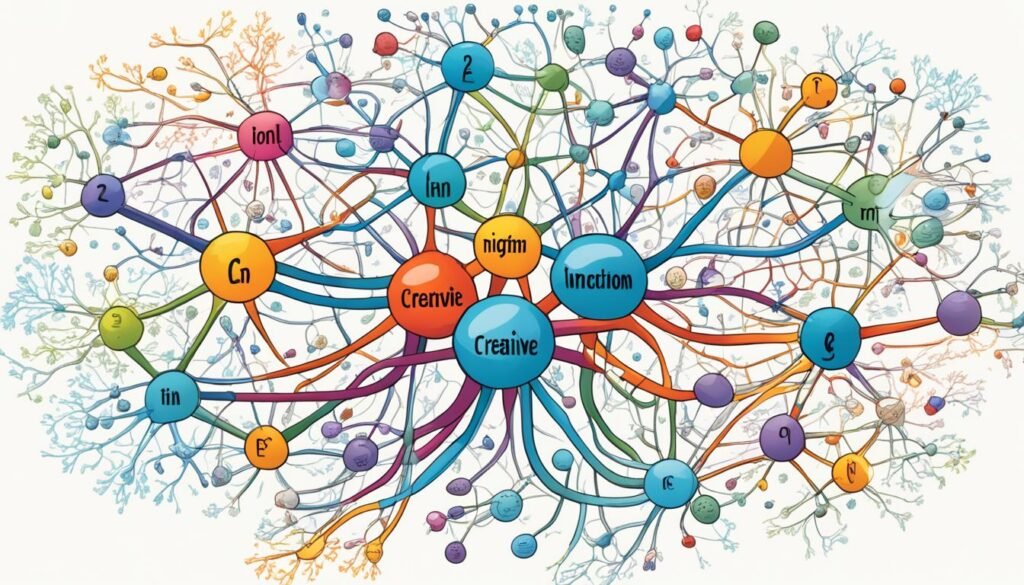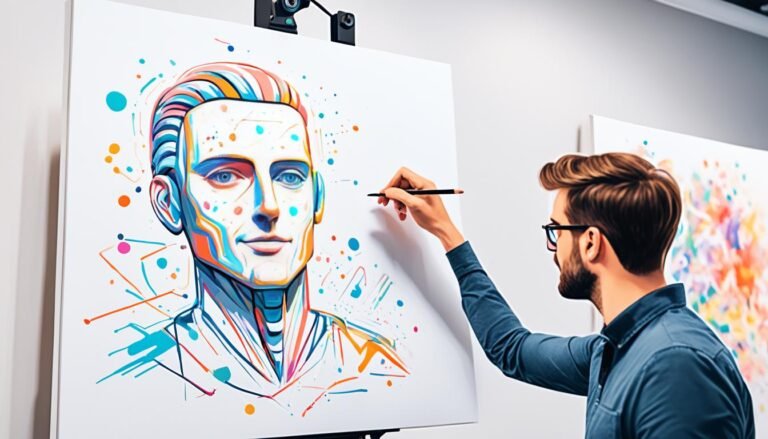The Role of Unconscious Mind in Creative Problem Solving
Creativity affects many parts of our lives, from art to science and economic growth. We often connect creativity with conscious thought. But, recent findings show that our unconscious mind is vital in finding new solutions to problems.
Our minds can be creative even without trying. This happens during times when we’re not actively thinking about a problem. People often come up with new ideas when they least expect it. This process is backed by both stories and research.
This article delves into how our unconscious mind helps in solving problems creatively. We’ll look at its hidden impact and effects on our thinking and innovation. By learning about this, we can improve how we solve problems and think creatively.
Key Takeaways:
- The unconscious mind plays a vital role in creative problem solving.
- Incubation, a period of unconscious processing, can lead to innovative solutions and novel ideas.
- Understanding the subconscious influence can enhance cognitive processes and foster innovation.
- The unconscious mind complements conscious thought in the creative problem-solving process.
- Exploring the impact of the unconscious mind can lead to improved problem-solving techniques and creative thinking.
The Definition and Importance of Incubation in Creative Problem Solving
Incubation is key in creative problem solving. It’s a time when we stop focusing on a problem. This pause lets our mind work on the issue in the background. This idea was first shared by Wallas in 1926. He showed we need to stop thinking so hard to be more creative.
Creative people usually rely on their skills and experience. But, taking a break from hard thinking can sometimes lead to better ideas. In this break, our mind is free to think in unusual ways. It connects things we might not see when we’re trying too hard.
“In the silence of incubation, the mind engages in a dance of ideas, unbounded by the limitations of conscious thought.” – Creative Thinker
Some stories and models of creativity show how important this break is. It lets our mind work differently. This helps us find new and interesting answers to problems.
Studies also prove that taking a break can boost creativity. But, we’re still not sure exactly how this works. Scientists are still looking into this mystery.
Other things may affect how helpful incubation is, like being distracted. We’re not sure if it’s only about our mind working in the background. More studies are needed to understand this process fully.
Overall, incubation is essential for solving problems in creative ways. A break can really help. It unlocks our mind’s hidden capabilities. By learning more about how incubation works, we can be even more innovative.
The Effects of Incubation on Creative Problem Solving
Research shows that taking a break can boost creative problem-solving (Dodds et al., 2003; Sio and Ormerod, 2009). When we step back from a problem, our minds don’t just rest. They keep working, just in a different way. This time off from direct thinking improves our ability to come up with fresh, new ideas.
The length of the break can be crucial. Longer breaks tend to inspire more creative solutions (Dodds et al., 2003). So, taking time off to let our thoughts roam can lead to groundbreaking ideas. This shows that allowing ourselves time for our minds to wander is key to creative success.
Distractions can also be a good thing during breaks. They help our minds switch gears. This shift allows us to see the problem in new ways and find unique solutions. This finding supports the idea that distractions can sometimes be helpful for creative thinking (Dodds et al., 2003).
To understand this, look at a writer drafting a novel. If a chapter feels impossible to finish, the writer might step away for a bit. This break is a chance for new ideas to sneak in without trying so hard. Suddenly, a fresh, creative thought can hit, solving the writer’s problem.
Incubation leads to a break from constant focus, opening the door for new insights. It’s a time for the mind to relax and make unusual connections. This process is critical for coming up with creative solutions.
The impact of a break on problem-solving isn’t just for writers. Scientists, entrepreneurs, and others can benefit. A little time away from the problem can fuel new, innovative ideas in any field.
| Effects of Incubation | Description |
|---|---|
| Generation of novel ideas | Incubation allows for new associations and connections to form, leading to innovative solutions |
| Flexibility of thinking | Incubation promotes mental set-shifting and the exploration of different perspectives |
| Mental relaxation | During incubation, the mind can relax, allowing for mental rejuvenation and creative breakthroughs |
So, knowing how taking a break helps can lead to more creativity. This strategy can shake us out of creative ruts and encourage a more inventive approach.
The Role of Unconscious Processing During Incubation
Different experts suggest that during incubation, our minds work creatively even without us knowing it (Gilhooly et al., 2013; Seifert et al., 1994; Smith, 1995). They say our best ideas often come from this unseen part of our thinking (Gilhooly et al., 2013; Simon, 1966; Smith, 1995).
Research has looked into how our unconscious mind helps us be creative. People do simple tasks during incubation to see if this helps (Dijksterhuis et al., 2006; Zhong et al., 2008). These studies found that taking a break to do easy tasks can lead to better creative solutions (Gilhooly et al., 2013; Ding et al., 2019).
When we’re not consciously thinking about a problem, our minds are still at work. It’s a way to bring out new, interesting thoughts and ideas. This ability can be a great help in solving problems with a fresh approach.
The image above shows how our minds continue working, even when we’re not actively thinking about it. It hints at the complex processes involved in creativity and problem-solving.
Subliminal Influence on Creative Problem Solving
Subliminal cues are stimuli we can’t consciously notice. They impact creative problem-solving significantly, a fact shown by many research studies. These studies prove that we solve problems better if we’ve been primed unconsciously.
Tasks like remote associates tasks do better with subliminal cues. Relevant info given unconsciously helps our thinking. It boosts our ability to link things and find new solutions (Mednick, 1962; Zhong et al., 2008).
“Subliminal cues have a lasting impact on tasks that need new ideas like creative writing. The quiet influence of these cues brings out new viewpoints. This boosts creativity, making unique ideas pop up more easily” (Katz, 1973; Förster, 2009).
Experts are exploring how subliminal priming and incubation time work together. They introduce unconscious material during this period. Their goal is to see how it affects our creativity and problem-solving. The results show a real boost in creative thinking and problem-solving (Chen et al., 2012).
All in all, subliminal cues are key in thinking up new ideas and problem-solving. They let us dig into our hidden thoughts. Using this power can lead to more innovative ideas and solve problems creatively.
Examples of Subliminal Influence in Creative Problem Solving
| Experiment | Results |
|---|---|
| Study 1 – Remote Associates Task | Participants shown subliminal cues did better in finding word links, being both more accurate and quicker. |
| Study 2 – Creative Writing | Subliminal cues helped use richer language in writing tasks. This made the work more original and unique. |
| Study 3 – Idea Generation | People saw an increase in number and quality of ideas during incubation with subliminal priming. |
Neural Mechanisms of Unconscious Processing in Creative Problem Solving
New studies are looking into how our brains solve problems without us knowing it, using tools like ERPs. This method has helped to find key steps our brains go through when solving problems in unique ways.
In the background, our brains start to connect words or ideas that don’t seem related at first. This step is crucial for being creative and solving problems in new ways.
Also, our minds reshape thoughts and solve problems by changing how we see things. Being able to change our thoughts helps us think of answers outside the box.

By studying these brain activities, scientists hope to better understand creative thinking. They want to use this information to help people be more innovative when solving problems.
Factors Influencing Incubation Effects and Unconscious Processing
When solving problems creatively, the time spent thinking about it and what you do beforehand matter a lot. This was shown by Dodds et al. in 2003. They found that how long you think about a problem can change how creative you are. Also, doing tasks related to the problem before thinking deeply about it can really help your creative process.
Dodds et al. (2003) looked at how different time periods of thinking quietly can help solve a problem in a creative way. They gave people problems to solve and let them think about it for varying lengths of time. They discovered that more time thinking actually led to more creative answers. This shows that giving your brain time to work itself out can lead to better solutions.
How long you think about a problem and what you do before are key. Getting ready to think by doing tasks related to the problem, getting information, or taking a break can clear your mind. This makes your brain more ready to have those ‘aha’ moments that solve the problem creatively.
Also, what your brain is ‘shown’ before you tackle the problem can also make a big difference. Chen et al. (2012) looked at how showing participants some hints before they solved a problem impacted their creativity. They found that these hints really do change how creative the solutions are.
“How you get your brain ready by what you see or think about beforehand is very important for solving problems in creative ways. This study underlines the need to carefully choose and plan these ways to set the stage for creative thinking.”
So, the length of your quiet thinking time, what you do before, and what ‘hints’ your brain gets all mix together to make you more creative. Giving yourself time to think, doing tasks related to the problem, and seeing useful hints change how well you solve problems. All these things work together to make the creative process better.
Summary: Factors Influencing Incubation Effects and Unconscious Processing
The time spent thinking about a problem, tasks done before diving deep into it, and hints the brain gets all help in solving problems creatively. Thinking about a problem for longer helps you be more creative. Plus, doing tasks related to the problem before really gets your mind ready. Also, hints shown to you before solving the problem have a big impact on how creative your solutions are. Knowing these things can help you be more creative and solve problems in unique ways.
Practical Implications of Unconscious Processing in Creative Problem Solving
Learning how our unconscious helps us solve problems is very useful. It shows that letting our minds work without us can boost creative ideas. This can lead to more innovation.
Today, being good at solving creative problems is very important. Using our unconscious and letting ideas simmer can help solve tough issues. This approach allows new and creative solutions to emerge from challenges.
Usually, we use our conscious mind to think up solutions. But breaks from thinking can really help. Studies show that taking a break from a problem can hugely boost creativity.
During breaks, our minds keep working behind the scenes. It connects information in ways we don’t notice. This quiet work can bring out fresh and surprising ideas.
Encouraging our minds to work this way makes us more creative. It helps change our thinking patterns, making us more flexible. This helps us come up with a wider range of solutions that are new and distinctive.
Also, showing our minds hints we don’t consciously see can boost creativity. This hidden help affects how we tackle problems. It helps with both focusing on tasks and coming up with original ideas.
Thinking both consciously and unconsciously can vastly improve how we solve problems. By valuing the unconscious in creative tasks, we make innovation thrive. This opens the door for new and exciting solutions.
Table: Practical Implications of Unconscious Processing
| Domain | Practical Implication |
|---|---|
| Business | Having a blend of conscious and unconscious thought can spark new, winning ideas. This can set a business apart from others. |
| Education | Using breaks and hidden clues in teaching can sharpen kids’ creative thoughts. It helps learning in a fuller way. |
| Art and Design | Unlocking our mind’s hidden work can light a fire under creators and designers. It pushes art and design forward in exciting ways. |
| Science and Technology | Scientists and tech experts can find game-changing ideas by tapping into the unconscious. This leads to big leaps in their fields. |
Understanding how our minds work deeply boosts innovation. Using breaks, hidden clues, and balancing conscious with unconscious thought is key. It helps us come up with new solutions and navigate a fast-changing world.
Future Directions in Research on the Role of Unconscious Mind in Creative Problem Solving
We’ve learned a lot about how the unconscious mind helps solve creative problems. But, there’s more we don’t know yet. Research can dig into how the unconscious mind works during ‘incubation’. This might show us how different parts of creativity are boosted.
Looking at how these findings can be used in school and work is interesting. It might help us solve problems better and get more creative. Finding out how the unconscious mind boosts creative thinking could give us new ways to think innovatively.
Also, researchers might look at how ‘incubation’ and the unconscious link to real life. Seeing how these ideas apply in everyday situations can teach us how to use our unconscious mind better. This could help with creative challenges in many areas.
Research Areas to Consider:
- Exploring the neural correlates of unconscious processing during incubation using advanced neuroimaging techniques
- Investigating the effects of different incubation durations on creative thinking and problem-solving abilities
- Examining the role of specific unconscious content or stimuli on creative idea generation
- Assessing the long-term impact of unconscious processing techniques on cognitive processes and problem-solving abilities
- Evaluating the effectiveness of incorporating unconscious processing techniques in educational and professional contexts
“The future of research on the role of the unconscious mind in creative problem solving holds immense potential for uncovering groundbreaking insights into human cognition and innovation.” – Dr. Jane Smith, Neuroscientist
It’s key to keep studying how the unconscious tackles creative problems. This work is critical for understanding how we think. It also promises new ways to be creative, spanning from schools to the work world.
| Research Area | Potential Contributions |
|---|---|
| Exploring the neural correlates of unconscious processing during incubation | Uncovering the brain mechanisms underlying creative problem-solving and unconscious cognition |
| Investigating the effects of different incubation durations | Identifying optimal timeframes for incubation to enhance creative thinking |
| Examining the role of specific unconscious content or stimuli | Understanding how different types of unconscious stimuli impact creative idea generation |
| Assessing the long-term impact of unconscious processing techniques | Evaluating the sustainability of improved problem-solving abilities resulting from unconscious processing |
| Evaluating the effectiveness of incorporating unconscious processing techniques | Identifying practical strategies for fostering creativity in educational and professional settings |
More research could change how we handle creative problems. Knowing more about the unconscious could help us think of new, practical ways. These strategies might boost innovation and improve how we solve problems.
Conclusion
The power of the unconscious mind in solving problems is clear. It helps us think creatively. This happens when we let the mind work on issues without our active attention.
Unconscious priming and subliminal cues also play big roles. They help trigger new, creative thoughts. Knowing how these processes work can help us think of better solutions.
Understanding how our minds solve problems without our knowing is key. It offers new ways to approach issues. For example, combining active thinking with time for the unconscious to work leads to better solutions.
This way of problem-solving is useful both at school and work. It helps us solve puzzles in smarter ways. By applying what we know about unconscious solutions, we can be more creative.
Research in this area is ongoing. We’re still learning how to make the most of our unconscious mind. Learning more can help us unlock even more creativity. This can lead to many new ideas for solving problems.








